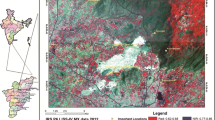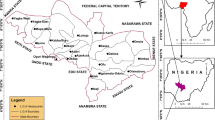Abstract
Groundwater is one of the most valuable natural resources, which is an immensely important and dependable source of water supply in all climatic regions over the world. Groundwater is in demand in areas where surface water supply is inadequate and nonsexist in the Chhatna Block, Bankura district and is located on the eastern slope of Chotonagpur Plateau, which is mapped on 73 I/15, 73 I/16 and 73 M/3, and falls between latitude 23°10′–23°30′N and longitude 86°47′–87°02′E. It represents plain land and gentle slope, which is responsible for infiltration and groundwater recharge. The groundwater in this region is confined within the fracture zones and weathered residuum. The present investigation is, therefore, undertaken to delineate potential zones for groundwater development with the help of a remote-sensing study. IRS–LISS-III data along with other data sets, e.g., existing toposheets and field observation data, have been utilized to extract information on the hydrogeomorphic features which include valley fills, buried pediment moderate, buried pediment shallow and structural hills, lineament density contour and slope map of this hard rock terrain. The target of this study is to delineate the groundwater potential zones in Chhatna block, Bankura District, West Bengal. Satellite imagery, along with other data sets, has been utilized to extract information on the groundwater controlling features of this study area. Three features (hydrogeomorphology, slope, and lineaments) that influence groundwater occurrences were analyzed and integrated. All the information layers have been integrated through GIS analysis and the groundwater potential zones have been delineated. The weighted index overlay method has been followed to delineate groundwater potential zones. The results indicate that good to excellent groundwater potential zones are available in almost the entire block. The results show that there is good agreement between the predicted groundwater potential map and the existing groundwater borehole databases. The area is characterized by hard rock terrain—still due to the presence of planation surface along valley fills; it became the prospective zone. The area has been categorized into four distinct zones: excellent, good, fair and poor. Excellent groundwater potential zones constitute 30–35 % of the total block area; good groundwater potential zones occupy a majority of the block, covering approximately 55–60 % and the fair potential zones occupy about 10–15 % of the total block. Poor potential zones occupy a very insignificant portion (less than 1 %).






Similar content being viewed by others
References
Acworth RI (1987) The development of crystalline basement aquifers in a tropical environment. Q J Eng Geol 20:265–272
Anbazhagan S, Ramasamy SM, Gupta DS (2005) Remote sensing and GIS for artificial recharge study, runoff estimation and planning in Ayyar basin, Tamil Nadu, India. Environ Geol 48:158–170
Assaf H, Saadeh M (2008) Geostatistical assessment of groundwater nitrate contamination with reflection on DRASTIC vulnerability assessment: The case of the upper Litani Basin, Lebanon. Water Resour Manag 23:775–796
Bonham-Carter GF (1994) Geographic information systems for geoscientists: modelling with GIS. Elsevier Science Ltd., USA, p 398
Chatterjee RS, Bhattachaya AK (1995) Delineation of drainage pattern of a coal basin related inference using satellite remote sensing techniques. Asia Pac Remote Sens J 1:107–114
Chenini I, Benmammou A, Elmay M (2010) Groundwater recharge zone mapping using GIS-based multi-criteria analysis: a case study in central Tunisia (Maknassy Basin). Int J Water Resour Manag 24:921–939
Choudhury PR (1999) Integrated Remote Sensing and GIS Techniques for Groundwater Studies in Part of Betwa Basin Ph.D. Thesis (unpublished), Department of Earth Sciences, University of Roorkee, India
Chowdhury A, Jha MK, Chowdary VM, Mal BC (2009) Integrated remote sensing and GIS-based approach for assessing groundwater potential in West Medinipur district, West Bengal, India. Int J Remote Sens 30(1):231–250
Dar IA, Sankar K, Dar MA (2011) Deciphering groundwater potential zones in hard rock terrain using geospatial technology. Environ Monit Assess 173:597–610. doi:10.1007/s10661-010-1407-6
Das D (1990) Satellite remote sensing in subsurface water targeting. In: Proceedings of ACSM-ASPRS annual convention, pp 99–103
Das D (1997) Enhancement analysis of geological linear features for groundwater information extraction. Abs vol. Int Conference on management of Drinking water: 1 CLRI Chennai
Das D, Kader A (1996) A Geomorphological approach for selecting the sites for artificial recharge of groundwater in the upper catchment area of the Kumari river basin, eastern India (Abs) ISM, Dhanbad, 35 Abs vol, 10th Convention of IGC
Davis SN, Turk LJ (1964) Optimum depth of wells in crystalline rocks. Ground Water 2(2):6–11
Detay M, Poyet P, Emsellem Y, Bernardi A, Aubrac G (1989) Development of the saprolite reservoir and its state of saturation: Influence on the hydrodynamic characteristics of drillings in crystalline basement (in French). C R Acad Sci Paris II 309:429–436
Drury SA (1990) Image interpretation in Geology 2nd edn. Chapman and Hall, London 281p
Gupta RP (1991) Remote sensing geology. Springer, Germany 356p
Gustavsson M, Kolstrup E, Seijmonsbergen AC (2006) A new symbol and GIS based detailed geomorphological mapping system: renewal of a scientific discipline for understanding landscape development. Geomorphology 77:90–111
Hajkowicz S, Collins K (2007) A review of multiple criteria analysis for water resource planning and management. Water Resour Manage 21:1553–1566
Hoffmann J, Sander P (2007) Remote Sensing and GIS in hydrogeology. Hydrogeol J 15(1):1–3
Horton RE (1945) Erosional development of streams and their drainage basins: Hydrophysical approach to quantitative morphology. Geol Soc Am Bull 56:275–370
Houston JFT, Lewis RT (1988) The Victoria Province drought relief project. II. Borehole yield relationships. Groundwater 26(4):418–426
Howard KWF, Hughes M, Charlesworth DL, Ngobi G (1992) Hydrogeologic evaluation of fracture permeability in crystalline basement aquifers of Uganda. Hydrogeol J 1:55–65
Jackson TJ (2002) Remote Sensing of soil moisture: implications for groundwater recharge. Hydrogeol J 10(1):40–51
Jaiswal RK, Mukherjee S, Krishnamurthy J, Saxena R (2003) Role of remote sensing and GIS techniques for generation of groundwater prospect zones towards rural development: an approach. Int. J. Remote Sensing 24(5):993–1008
Jasrotia AS, Kumar R, Saraf AK (2007) Delineation of groundwater recharge sites using integrated remote sensing and GIS in Jammu district, India. Int J Remote Sens 28(22):5019–5036
Kamal ASMM, Midorikawa S (2004) GIS-based geomorphological mapping using remote sensing data and supplementary geoinformation: a case study of the Dhaka city area, Bangladesh. Int J Appl Earth Obs Geoinf 6:111–125
Kumar A, Srivastava SK (1991) Geomorphological units, their geohydrologicalcharacteristics and vertical electrical sounding response near Munger, Bihar. J Ind Soc Remote Sens 19(4):205–215
Kumar PK, Gopinath G, Seralathan P (2007) Application of remote sensing and GIS for the demarcation of groundwater potential zones of a river basin in Kerala, southwest coast of India. Int J Remote Sens 28(24):5583–5601
Kumar MG, Agarwal AK, Bali R (2008) Delineation of potential sites for water harvesting structures using remote sensing and GIS. J Indian Soc Remote Sens 36:323–334
Lachassagne P, Wyns R, Berard P, Bruel T, Cery L, Coutand T, Desprats JF, Le Strat P (2001) Exploitation of high-yield in hard-rock aquifers: Downscaling methodology combining GIS and multimedia analysis to delineate field prospecting zones. Ground Water 39(4):568–581
Lilesand TM (1989) Remote sensing and image interpretation. Wiley, USA, p 721
Madrucci V, Taioli F, De-Araujo CC (2008) Groundwater favorability map using GIS multicriteria data analysis on crystalline terrain, Sao Paulo State, Brazil. J Hydrol 357:153–173
Murthy KSR (2000) Groundwater potential in a semi-arid region of Andhra Pradesh: a geographical information system approach. Int J Remote Sens 21(9):1867–1884
Muthukrishnan A, Manjunatha V (2008) Role of remote sensing and GIS in artificial recharge of the groundwater aquifer in the Shanmuganadi sub water shed in the Cauvery River Basin, Tiruchirappalli District, Tamil Nadu. GIS Ideas, 4–6 December 2008
Nag SK (2005) Application of lineament density and hydrogeomorphology to delineate groundwater potential zones of Baghmundi block in Purulia district, West Bengal. J Indian Soc Remote Sens 33(4):522–529
Saraf AK, Choudhury PR (1997) Integrated application of remote sensing and GIS groundwater exploration in hard rock terrain. In: Proceedings of International Symposium on Emerging trends in Hydrology, Department of Hydrology, Roorkee, September 25–27, 1:435–442
Saraf AK, Choudhury PR (1998) Integrated remote sensing and GIS for groundwater exploration and identification of artificial recharge sites. Int J Remote Sens 19(10):1825–1841
Sarma B, Saraf AK (2002) Study of Landuse - Groundwater relationship using an integrated remote sensing and GIS approach. Map Asia 2002. http://www.gisdevelopment.net
Sener E, Davraz A, Ozcelik M (2005) An integration of GIS and remote sensing in groundwater investigations: a case study in Burdur, Turkey. Hydrol J 13:826–834
Sharma D, Jugran DK (1992) Hydromorphological studies around Pinjaur-Kala Amb area, Ambala district (Hariana), and Sirmour district (Himachal Pradesh). J Indian Soc Remote Sens 29(4):281–286
Singh AK, Parkash B, Choudhury PR (2007) Integrated use of SRM, Landsat ETM + data and 3D perspective views to identify the tectonic geomorphology of Dehradun valley, India. Int J Remote Sens 28(11):2414–2430
Sreedevi PD, Subrahmanya K, Ahmed S (2005) Integrated approach for delineating potential zones to explore for groundwater in the Pageru River basin, Cuddapah District, Andhra Pradesh, India. Hydrol J 13:534–543
Srivastava PK, Bhattacharya AK (2006) Groundwater assessment through an integrated approach using remote sensing, using remote sensing, GIS and resistivity techniques: a case study from a hard rock terrain. Int J Remote Sens 27(20):4599–4620
Subba Rao N, Chakradhar GKJ, Srinivas V (2001) Identification of groundwater potential zones using remote sensing techniques in and around Guntur town, Andhra Pradesh, India. J Indian Soc Remote Sens 29(1,2):69–78
Taylor R, Howard K (2000) A tectono-geomorphic model of the hydrogeology of deeply weathered crystalline rock: evidence from Uganda. Hydrogeol J 8(3):279–294
Tiwari A, Rai B (1996) Hydrogeological mapping for groundwater prospecting using Landsat–MSS images: a case study of part of Dhanbad district, Bihar. J Indian Soc Remote Sens 24(4):281–286
Wright EP (1992) The hydrogeology of crystalline basement aquifers in Africa. In: Wright EP, Burgess WG (eds) Hydrogeology of crystalline basement aquifers in Africa. Special Publication 66. Geological Society, London, pp 1–27
Wyns R, Baltassat JM, Lachassagne P, Legchenko A, Vairon J, Mathieu F (2004) Application of SNMR soundings for groundwater reserves mapping in weathered basement rocks (Brittany, France). Bull Soc Geol Fr 175(1):21–34
Acknowledgments
The author (SKN) gratefully acknowledges the financial support from Centre of Advanced Study (CAS-Phase IV), Department of Geological Sciences, Jadavpur University in conducting the field work related to this work. The other author (P. Ghosh) is thankful to University Grants Commission, New Delhi and Jadavpur University also for providing the UGC Research Fellowship in Science for Meritorious Student 2007–2008 to her.
Author information
Authors and Affiliations
Corresponding author
Rights and permissions
About this article
Cite this article
Nag, S.K., Ghosh, P. Delineation of groundwater potential zone in Chhatna Block, Bankura District, West Bengal, India using remote sensing and GIS techniques. Environ Earth Sci 70, 2115–2127 (2013). https://doi.org/10.1007/s12665-012-1713-0
Received:
Accepted:
Published:
Issue Date:
DOI: https://doi.org/10.1007/s12665-012-1713-0




